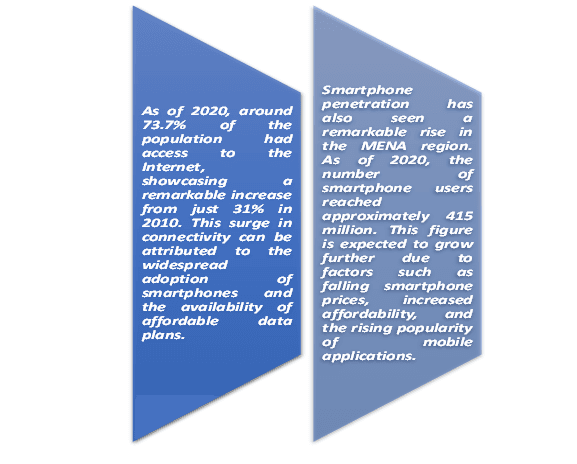MENA Digital Economy Market Seen Soaring 22.1% Growth to Reach USD 886.1 billion by 2030, Projects UnivDatos Market Insights
Author: Himanshu Patni
16 December 2023
According to a new report by UnivDatos Market Insights, the MENA Digital Economy Market is expected to reach USD 886.1 billion in 2030 by growing at a CAGR of 22.1%. The digital economy refers to an economy that is based on digital technologies and internet connectivity. It encompasses all economic activities that are conducted through digital platforms, such as online shopping, mobile payments, digital advertising, and online services like cloud computing and software as a service (SaaS). In a digital economy, traditional industries and sectors are transformed by leveraging digital technologies to improve efficiency, productivity, and innovation. It encompasses both online businesses, like e-commerce companies and digital service providers, as well as traditional industries that have adopted digital processes and technologies. The digital economy has allowed for the growth of global connectivity and the seamless exchange of information and services across borders. It has also enabled new business models and job opportunities, such as gig economy platforms and freelance marketplaces.
Access sample report (including graphs, charts, and figures) – https://univdatos.com/get-a-free-sample-form-php/?product_id=51396
The MENA digital economy market has been experiencing significant growth in recent years, driven by factors such as increasing internet and smartphone penetration, a young and tech-savvy population, government initiatives to promote digital transformation, and a growing entrepreneurial ecosystem. The UAE, Saudi Arabia, and Egypt are the leading markets for the MENA digital economy, with these countries attracting significant investments and witnessing rapid growth in digital business activities. Other countries in the region, such as Jordan, Lebanon, and Morocco, also have emerging digital economies and are seeing a rise in technology startups and digital entrepreneurship. Challenges in the MENA digital economy market include issues of digital inclusion and accessibility, regulatory hurdles, payment infrastructure limitations, and cybersecurity concerns. However, efforts are being made by governments and organizations to address these challenges and promote the growth of the digital economy in the region.
Increasing Internet and Smartphone Penetration
The internet and smartphone revolution in MENA has paved the way for new opportunities in various sectors, ranging from e-commerce and e-government to digital entertainment and financial technology. Over the past decade, there has been a significant rise in internet connectivity across the MENA region. According to a report by the Dubai-based Mohammed bin Rashid School of Government, internet penetration in the Arab world reached 70 percent in 2019, compared to just 18 percent in 2005. This rapid growth in internet usage can be attributed to several factors, including the expansion of mobile networks, increased affordability of smartphones, and the availability of localized digital content.
Another crucial factor contributing to the rising internet and smartphone penetration in MENA is the region’s young and tech-savvy population. Approximately 60 percent of the MENA population falls under the age of 30, making it one of the most youthful regions globally. The younger generation has embraced digital technology, and their demand for internet and smartphone access has been a catalyst for increased connectivity in the region.
Moreover, the MENA region has witnessed the emergence of a vibrant start-up ecosystem, with many innovative entrepreneurs leveraging internet and smartphone technology to develop their ideas. This has led to the birth of a diverse range of tech start-ups, creating jobs and driving innovation across various sectors, including health, education, and transportation.

Rising Trend of E-learning and EdTech
E-learning and edtech have seen significant growth and development in the MENA digital economy in recent years. With increased internet penetration and the proliferation of smartphones, more individuals in the region now have access to affordable and convenient digital learning platforms. For instance, platforms like Coursera, Udemy, and EdX have gained popularity, offering a wide range of online courses and certifications. Additionally, educational institutions and governments in the MENA region are actively adopting edtech solutions to enhance the learning experience. For example, the Saudi Arabian government launched the “Madrasati” initiative, providing digital resources and tools to teachers and students. Similarly, the United Arab Emirates introduced the “Madares” program, focusing on e-learning and the integration of technology in classrooms. These recent developments highlight the increasing importance of e-learning and edtech in fostering education and driving economic growth in the MENA digital economy.
For a detailed analysis of the MENA Digital Economy Market browse through – https://univdatos.com/report/mena-digital-economy-market/
Conclusion:
the MENA digital economy market is projected to reach USD 886.1 billion by 2030, driven by factors such as increasing internet and smartphone penetration, a young and tech-savvy population, government initiatives, and a growing entrepreneurial ecosystem. The UAE, Saudi Arabia, and Egypt are leading markets in the region, attracting investments and experiencing rapid digital business growth. Other countries like Jordan, Lebanon, and Morocco also have emerging digital economies and are witnessing the rise of technology startups and digital entrepreneurship. Challenges such as digital inclusion, regulatory hurdles, payment infrastructure limitations, and cybersecurity concerns are being addressed by governments and organizations. The internet and smartphone revolution, along with the region’s young population and vibrant startup ecosystem, have contributed to the growth and opportunities in various sectors.
Get a call back
